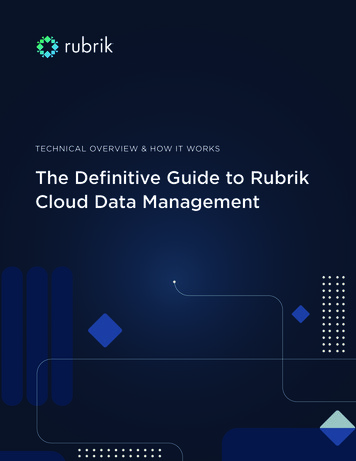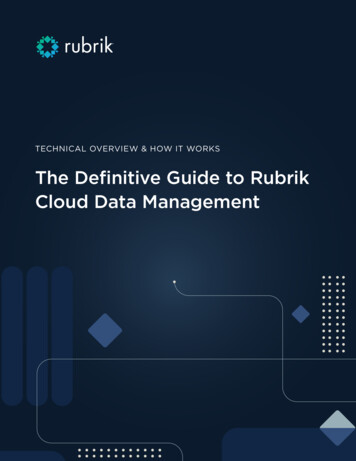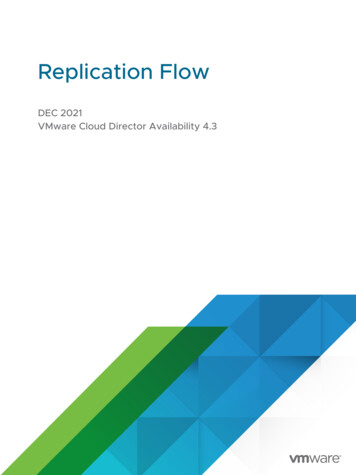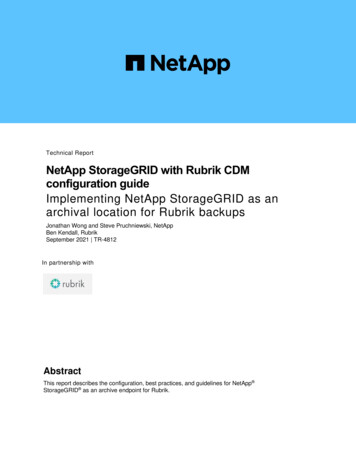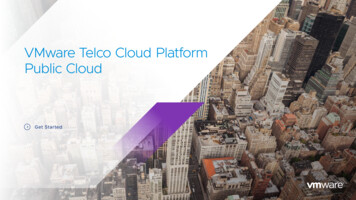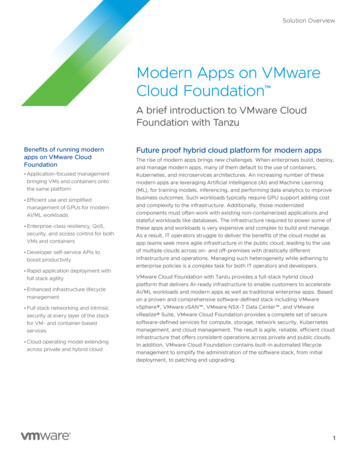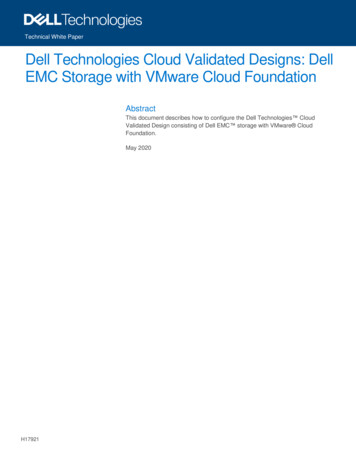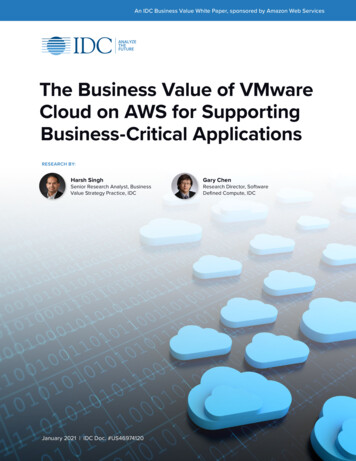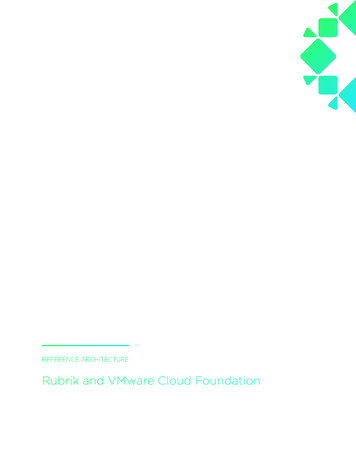
Transcription
REFERENCE ARCHITECTURERubrik and VMware Cloud Foundation
TABLE OF CONTENTS3INTRODUCTION3AUDIENCE4SOLUTION OVERVIEW1919Compute Workload Domains20 Management Workload DomainComponents4VMware vSphere Storage APIs - DataProtectionPlatform Service Controllersand vCenter ServerRecoverability5Rubrik’s Approach to AdaptiveConsistencySDDC ManagerRecoverability5Recovery MethodsNSX Recoverability6Instant RecoveryvRealize Log InsightRecoverability7Live MountvSAN Recoverability8Export9File-Level Recovery2323 Test and DevelopmentRestore by Download24 Migrate to a New SDDC andMaintain Backup History10 Declarative Policies and SLA Domains10 SLA Domains13Assigning SLA Domains13Protection Overview24 CloudOut (Archival)25 CloudOn (Instantiation)26 Day 0 - 2 Ops with API /Integrations Use CasesPerformance and ScalabilityBackup Processes26 Automatic Policy-Based DataProtection with New ComputeWorkload DomainsARCHITECTURAL OVERVIEW1627 Integration with vRealizeAutomation for Complete VMLifecycle ManagementVMware Cloud Foundation Architecture16SDDC Manager17Workload DomainsManagementWorkload DomainOPERATIONAL OVERVIEW23 Use CasesDirect Restore15Protecting and Restoring VMware CloudFoundation28CONCLUSION28ABOUT THE AUTHORSCompute Workload Domains29 APPENDIX A - EXAMPLE INVENTORYAND CONFIGURATION GATHERINGSCRIPT
INTRODUCTIONVMware Cloud Foundation is an integrated software platform that provides a complete set of software-defined servicesfor compute (VMware vSphere), storage (VMware vSAN), networking (VMware NSX for vSphere and NSX-T), and cloudmanagement (VMware vRealize Suite).VMware Cloud Foundation provides fully automated deployment and lifecycle management of the VMware Software DefinedData Center (SDDC), and is designed to be deployed on premise or consumed as a service in the public cloud.Cloud Foundation is engineered to be simple, unlocking greater agility and productivity by eliminating the operationalbottlenecks associated with traditional administrative silos of legacy infrastructure. It accomplishes this by delivering: Integrated Stack—Engineered integration into a single solution for the entire software-defined stack with guaranteedinteroperability. No more complex interoperability matrixes to deal with. Software-Defined—Infrastructure is entirely defined in software and inherently highly dynamic, scalable, and hardwareindependent. Underlying physical hardware is completely abstracted into logical pools that can be flexibly allocated toindividual [JS1] tenants or applications. Automated Deployment of a Standardized Architecture—The Cloud Foundation initial deployment is fully automatedthrough the use of the VMware Cloud Builder appliance. Cloud Foundation deployments are deployed in accordancewith the standardized architecture defined in VMware’s Validated Designs (“blueprint” documentation for buildingthe VMware SDDC). Cloud Builder deployment validation and automation capabilities ensure quick and repeatabledeployments while eliminating risk of faulty configurations. Automated Resource Provisioning—Cloud Foundation creates and maintains logical infrastructure pools of compute,storage and network resources, making it easy to scale as business needs grow. Automated Lifecycle Management—Cloud Foundation includes unique lifecycle management (automated patchingand upgrades) for all the products that it deploys. Validated and tested upgrade bundles are downloaded by SDDCManager and provide intuitive, click button deployment of patches and upgrades. Common operational tasks such aspassword rotation and SSL certificate creation and replacement are automated through workflows in SDDC Manager.Pairing Rubrik with VMware Cloud Foundations allows for automated data protection of both the management and computeworkloads deployed within VCF, ensuring resources are protected and available in the event disaster strikes. Rubrik’s simplisticand automated processes work together with VCF lifecycle management to truly provide a holistic data managementsolution for customers.AUDIENCEThis reference architecture is intended to provide CTOs, solutions architects, and administrators with information about thearchitecture, implementation, and benefits of an integrated Rubrik and VMware Cloud Foundation solution.For the remainder of this document, “virtual machines” will be referred to as “VMs,” “disaster recovery” as “DR,” and “VMwareCloud Foundation” as VCF.REFERENCE ARCHITECTURE RUBRIK AND VMWARE CLOUD FOUNDATION3
SOLUTION OVERVIEWVMware Cloud Foundation is the unified Software-Defined Data Center (SDDC) platform that brings together vSphere,vSAN, vRealize, and NSX into a natively integrated stack to deliver enterprise-ready cloud infrastructure for bothprivate and public cloud.Pairing Rubrik with VCF brings automated data protection to the SDDC and provides a variety of use cases and methodsto ensure that both the management and workload VMs are protected and available. Utilizing an automated policy-drivenapproach through the assignment of Rubrik SLA Domains, consumers of Cloud Foundation not only gain simplicity around themanagement of the underlying infrastructure, but can be rest assured that the workloads consuming cloud resources can berestored with near-zero RTOs, both at a file and image level.Rubrik and VMware Cloud Foundation work in harmony to provide a true cloud infrastructure platform, delivering softwaredefined services built around compute, storage, network, security, and data management / protection.VMWARE VSPHERE STORAGE APIS - DATA PROTECTIONThe vSphere Storage APIs for Data Protection (VADP) is a framework put forth by VMware that allows products to requestand retrieve VM data in a consistent manner. Rubrik fully utilizes VADP in order to backup vSphere VMs without the use ofthird-party agents, offloading the backup processing of the individual VMs to the ESXi hosts and the Rubrik cluster. Leveragingthe snapshot capabilities within vSphere, VADP and Rubrik are able to perform backups non-disruptively, no longer requiringextended backup windows or downtime. Ultimately, VADP offload reduces production overhead, allowing organizations to runmore VMs per host, in turn reducing the overall costs associated.In the case of Rubrik and VMware Cloud Foundation, leveraging the vSphere Storage APIs for Data Protection also ensuresthat architectural decisions around storage are largely made moot. Regardless of the underlying storage decisions made withVMware vSAN, the usage of VADP abstracts the nuances present with the selected datastore storage provider.When data is requested by the Rubrik cluster, the vSphere API layer is used to negotiate with the ESXi hypervisor hosting theprotected workload to retrieve the needed data from the datastore and transmit it back to the Rubrik cluster. Additionally, theindividual node choice within the Rubrik cluster is handled in an automated fashion in which the CDM software determines theprimary candidate(s) for establishing a session and receiving data.At a high level, the successful request to begin a backup of a VM kicks off a workflow requesting that the ESXi host runningthat particular workload initiate a VMware snapshot. This snapshot action is intended to redirect storage IO to a snapshotdisk, thus freeing the hypervisor’s lock on the underlying base disk(s). Subsequent actions are focused on retrieving the datato be parsed and stored by the requesting Rubrik cluster. Once finished, the VMware snapshot is consolidated (removed),and storage IO returns to the base disk(s). While there are other decision points available in the workflow, such as adaptiveconsistency and pre- and post-scripts, the basic flow has been represented.ConfigureSLA Domain pre-scriptVM Snapshot post-scriptApplySLA DomainBackup beginsIncremental backup stored onRubrik clusterREFERENCE ARCHITECTURE RUBRIK AND VMWARE CLOUD FOUNDATION4
It is worth noting that the process of negotiation, session instantiation, and data transmission is secured using an SSLencrypted Network Block Device protocol and SSL encryption (NBDSSL) transport mode.RUBRIK’S APPROACH TO ADAPTIVE CONSISTENCYWhen dealing with consistency within recovery points, backups can be classified into three broad categories: inconsistent,crash consistent, and application consistent.Inconsistent backups are taken by copying data only located on the disks of the VMs. In-memory changes or any transactionsin progress are not captured within an inconsistent recovery point. Inconsistent backups may only be suited for the most basicof workloads and are not recommended for high-transactional, complex systems.When crash-consistent backups are taken, the complete state of the VM is captured at a given point in time, resulting in anexact duplicate of the data from which the backup began. Although crash-consistent backups are sufficient for most modernworkloads, in-memory and transactions in progress are still not captured.Application-consistent backups, like crash-consistent, capture all of the VM’s data at a given point in time. The difference,however, is that application-consistent backups will pause and wait for applications within the system to flush I/O operationsand complete any transactions in progress.Rubrik takes a stepped approach to perform application-consistent backups of VMs. First, Rubrik polls the VM to see if theRubrik Backup Service (RBS) is listening. RBS is a lightweight service that can orchestrate application-consistent backups byutilizing an included custom VSS provider. This VSS provider enables functionality around application-consistent features suchas flushing SQL Server and Exchange logs along with waiting for in-memory transactions to complete. Rubrik can also enablethe automatic installation of the RBS service if it is not found, but this functionality is not enabled by default.Note: When RBS is installed on VMs, it is utilized only for application-consistent, VSS purposes during a vSphere backup.The processes around the movement of data remain the same as if RBS wasn’t installed, utilizing VADP and NBDSSL.If RBS is not found or cannot be installed, Rubrik will push an ephemeral agent containing a custom VSS provider into theVMs through the vSphere Virtual Infrastructure eXtension (VIX) APIs during the backup process. VIX is an API developed byVMware that allows Rubrik to leverage and perform guest management operations within the VMs being backed up. After theephemeral agent has been deployed, Rubrik will first attempt to perform an application-consistent backup. If an applicationconsistent backup is not possible, Rubrik will create a notification around the event and will proceed with processing acrash-consistent backup.Rubrik’s approach to adaptive consistency marries the options of having flexibility within the platform to perform applicationconsistent backups with the simplicity of providing a solution that is easy to use with minimal configuration. Rubrik willautomatically and adaptively conform to the best path possible for the VM as it pertains to data consistency, ensuring thateven if the optimal method is not chosen, the backup is still performed with the properly associated notifications.RECOVERY METHODSRubrik provides a variety of methods to recover VMs and restore protected data. Recoverable data within the Rubrik CDMplatform can exist in three locations: Local snapshots Replicated snapshots Archived snapshots.REFERENCE ARCHITECTURE RUBRIK AND VMWARE CLOUD FOUNDATION5
Note: While the term snapshot exists both within the vSphere and Rubrik platform, they represent entirely differentunderlying technologies. A vSphere snapshot exists within the source production environment, while a Rubrik snapshotalways represents a point-in-time copy of your production data located within the Rubrik CDM. The remainder of thissection references Rubrik snapshots.When snapshot data exists in a local snapshot and in an archived snapshot, the Rubrik cluster always uses the local snapshotto recover a VM or to restore data. By using the local snapshot, the Rubrik cluster reduces network impact and eliminates anyarchival data recovery charges associated with a recovery operation or a restore operation.INSTANT RECOVERYRubrik’s Instant Recovery can be used to recover VMs that are no longer functioning correctly because of: Corruption or malware Accidental deletion Any other service disruptionThis functionality allows mounting restored VMs data directly off the Rubrik system, thus reducing the recovery time.Let’s visualize the Instant Recovery workflow:The process first begins by selecting the VM, snapshot date, and recovery host. You may choose to remove a virtual networkdevice if any networking changes or issues would prevent the VM from successfully powering on. This methodology alsoenables validation of certain services after recovery but before restoring the service.Additionally, you may select to preserve the VM-managed object ID (MoRef). This is a managed object ID, which isapplicable to vSphere VMs. It will ensure that the VM is recovered using the same MoRef as a part of VM linking, ratherthan it being recovered as a new object. This method can be important for preserving workflows built around this VM.See the VM Linking section for more information.At this point, the Rubrik system presents itself as an NFS v3 datastore to ESXi. If the original VM still exists within the vCenterServer inventory, it will be deprecated (renamed) before the process continues.Rubrik coordinates the addition of the newly recovered VM into the vCenter Server inventory. A new copy of the VM runningon Rubrik is presented and powered on and services resume.VMOriginalDeprecatedVMRecoveredvCenter ServerNearZeroREFERENCE ARCHITECTURE RUBRIK AND VMWARE CLOUD FOUNDATION6
Post-recovery, users can utilize VMware’s Storage vMotion to migrate the workload back to the primary storage array.PrimaryStorageStorage vMotionRubrikNFSUltimately, Rubrik serves as a storage endpoint to recover as many vSphere VMs as needed, thus eliminating the complexityand time wasted in transferring data back into the production system. This functionality provides a near-zero recovery timeand restores user access near instantly.During the process, messages about the recovery status appear in the Notifications section of the Rubrik UI. The Rubrik clusterrecords the final result of the task in the Activities Log, available via the Rubrik UI.The instantly recovered VM derives protection from parent objects. When the recovered VM does not derive protection fromany parent objects, add it to an SLA Domain. To protect it using the same SLA rules and policies as the source VM, add therecovered VM to the original SLA Domain or to another SLA Domain. With VM linking, the new VM is linked with the old VM,which preserves the entire snapshot history.LIVE MOUNTLike Instant Recovery, Rubrik becomes an NFS v3 datastore from vSphere ESXi hypervisor perspective. Instead of deprecatingthe original VM, a VM similar to the original is created from the point in time selected but with a trailing date timestampappending the VM name. The original VM is not altered. Additionally, in order to avoid IP or MAC address conflicts, the LiveMount VM has its NIC disabled by default.VMOriginalVMMountvCenter ServerNearZeroNFS v3REFERENCE ARCHITECTURE RUBRIK AND VMWARE CLOUD FOUNDATION7
This functionality appeals to application owners and operations teams in order to conduct: Functional or regression testing Application development Software release testing (upgrade the actual applications)Build isolated environments and leverage the Live Mount feature to instantiate an identical environment in moments. TestVMware Tools or hardware version upgrade, failure scenario, and other use cases using your backup storage. When done,simply throw it away. The production VM, along with any of its associated backups, remain unscaithed.No additional configurations are needed on the hypervisor side for Live Mount functionality to work. Simply provide a serviceaccount with the documented permissions required for the type of virtualization environment. Rubrik automates the entireprocess. VMs of any size can be recovered in the amount of time it takes for the OS to boot. Imagine having the ability to spinup an 8 TB VM in under 2 minutes so that a recovery point can be validated by an administrator or application owner.EXPORTWhile Instant Recovery and Live Mount utilize the Rubrik resources to facilitate a fast, near-zero RTO recovery, there may betimes when a traditional restore method is preferred. The Export recovery method within Rubrik provides just this, recoveringthe VM by transferring data from the Rubrik cluster back to a production environment.Export creates a new VM within vCenter from a point-in-time copy of the source VM located on the Rubrik cluster, allowing anew ESXi host to be chosen along with the selection of any target datastore to host the recovered VM.The Rubrik cluster assigns a new name to the recovered VM and powers it on. However, as a safeguard, the recovered VM is notautomatically connected to a network. This enables validation of certain services or applications after the recovery but beforecompletely restoring access to the service.VMOriginalVMExportvCenter ServerExportThis functionality appeals to application owners and operations teams in order to conduct: Recovery after a primary storage failure to another location Restoration of services to a different host/cluster Functional or regression testing requiring the VM to be available on a long-term basisCoupling Instant Recovery together with VMware’s Storage vMotion will almost always result in lower recovery times, butExport is an option for those with a use case revolving around traditional restores.REFERENCE ARCHITECTURE RUBRIK AND VMWARE CLOUD FOUNDATION8
FILE-LEVEL RECOVERYThe Rubrik cluster provides file-level restore (FLR) of files and folders from any local snapshot, replica, or archival snapshot thatwas successfully indexed.Note: When performing file-level restores from an archived snapshot, either on-prem or in the cloud, only thoserequired blocks comprising the file are retrieved. Rubrik eliminates the need to download entire virtual disks (.vmdk)by storing the metadata with the archived snapshots. This saves organizations high egress charges associated with thechosen cloud provider.To restore a file or folder, search for it by name across all local snapshots. You can also browse for the file or folder ona selected snapshot.Files and folders may be restored directly to the source system or downloaded to the local workstation.DIRECT RESTOREFor supported Windows and Linux guest operating systems, the Rubrik cluster can restore files and folders directly tothe source file system.When restoring from a snapshot of a supported guest operating system, the Rubrik UI provides the option to restore a file orfolder directly to the source file system. When this option is selected, the Rubrik UI provides a choice to overwrite the sourcefile or folder, or to restore the file or folder to another location.A restored file or folder inherits the access control of the parent folder and the same owner as the parent folder. The restoredfile or folder retains the modification time (mtime) of the source file or folder at the time of the snapshot.To successfully restore directly to the source file system, the Rubrik cluster must be provided the following information: Resolvable hostname or IP address of the authentication server Username of an account with administrator privileges for the target Password for the accountWhen the Rubrik cluster has previously accepted the service credentials of a guest operating system, the restore job doesnot require additional credential information. This feature requires that the Rubrik cluster has successfully used the servicecredentials for at least one backup prior to the restore task. Otherwise, the credentials can be provided through the RestoreFile dialog during the restore task.RESTORE BY DOWNLOADThe Rubrik cluster generates download links to use for file-level restore (FLR) of files and folders from any local snapshot,replica, or archival snapshot that was successfully indexed. The guest OS of the source VM must have a current version ofVMware Tools running to enable successful indexing.Restore a file from a data protection object through the Rubrik cluster Rubrik UI. Once the file is selected, the Rubrik clusterprocesses the request and provides a link for download of the file.When restoring a folder, the Rubrik cluster generates a .ZIP file containing the folder and all its contents. The .ZIP file retainsthe hierarchy of the selected folder. The Rubrik cluster provides a link for downloading the .ZIP file.REFERENCE ARCHITECTURE RUBRIK AND VMWARE CLOUD FOUNDATION9
DECLARATIVE POLICIES AND SLA DOMAINSTraditional architecture has long been ruled by the imperative operational model. Historically, administrators have taken somepiece of infrastructure and then told it exactly what to do to meet the desired end state. In terms of data lifecycle management,this translates to defining what objects to protect, target destinations, creation and expiration schedules, storage requirements,and so on. Each job requires a non-trivial amount of daily management to function. If there are issues with the job, anadministrator must triage the job to determine where the failure occurred (along with re-running the job at a later date).One of the most positive and impactful shifts in enterprise architecture has been the move towards the declarative model.This refers to the ability to express business needs directly to the systems that run applications with the intent of allowing anintelligent fabric of components to make real-time decisions on your behalf.The declarative model allows technical professionals to plug in their desired state for an object – in this case, the dataprotection policy for VM workloads – into a policy engine. This engine is elegantly simple because all of the imperative detailsare abstracted away and handled by an incredibly smart, scale-out system. The resulting input fields are reduced to: The Recovery Point Objective (RPO) requirement Retention periods for the aforementioned RPOs Any archive targets, if desired Any replication targets for near-zero RTO requirements, if desiredPolicy is logically assigned to vSphere objects: VMs, folders, data centers, clusters, or even entire vCenter Servers, as wellas constructs outside of vSphere, such as physical workloads, SQL databases, etc. Any of the “jobs,” per se, are completelyabstracted away by the system. The declarative policy engine funnels your RPO, RTO, availability, and replication requirementsinto system-level activities. This is where the true value of the system resides – the ability to control end-to-end ingest,placement, and archive for all protected pieces of data. Just set a policy and allow the system to do all of the heavy lifting.This is how the technology industry as a whole is going to tackle the ever-increasing demands for doing more with less, fasterand more efficiently.As an example, imagine you have invited someone over to your house. In order for the person to arrive at your home, you mustgive exact directions -- “start by going straight down Main Street, then right at the In-N-Out Burger, ensure to follow the stoplight instructions at the intersection of 1st Ave and A Street. My house is the ninth house on the left past that intersection.” Thisis the imperative model of thinking. Alternatively using a declarative model, I could say “my address is 16 National Ave; input itinto a GPS app -- it will navigate you using the best route.”Rubrik is firmly rooted in the declarative approach; as an administrator, you simply define the desired end state (RPO, retention,replication, archival, etc.) and allow the intelligent software to make it reality. In essence, govern infrastructure and applicationsusing declarative policy rather than imperative jobs.SLA DOMAINSRubrik orchestrates the movement of data from initial ingest and propagation of that data to other data locations, such asreplicating to remote clusters or Rubrik Cloud Cluster, as well as data archival. A single SLA policy is used to dictate all datalifecycle specifications, and the data control plane does the rest.REFERENCE ARCHITECTURE RUBRIK AND VMWARE CLOUD FOUNDATION10
For this section, an example SLA policy is: Take a backup:–– Run a snapshot every 4 hours and retain hourly backups for a day–– Run a snapshot every month and retain monthly backups for 7 years Archive to Amazon S3 after 30 days Replicate data to another Rubrik cluster and retain for 45 daysREFERENCE ARCHITECTURE RUBRIK AND VMWARE CLOUD FOUNDATION11
Data is ingested and retained according to the frequency specified in the SLA policy. The example policy is configured to store30 days of data within the Rubrik cluster. Once that period has elapsed, data is archived to another location for long-termretention. In this case, data is archived to Amazon S3 for another 6 years and 334 days. There is no need for an administrator tomanage, prune, or validate that data has been archived; these activities are all handled natively by Rubrik to reflect how theywere expressed in the SLA.The policy also specifies to replicate data from one Rubrik instance to another. For example, a remote office/branch office(ROBO) may replicate workloads into the main data center using Rubrik or a primary site may replicate to a DR site. Eliminateconfiguring and managing this functionality at the storage layer. Apply policy-based management to workloads and stopbabysitting data residing across multiple data centers.Note: Rubrik provides three built-in SLA Domains by default—each representing a set level of protection: Gold (highest protection)Silver (medium protection)Bronze (lowest protection)Administrators may choose to use the built-in SLA Domains or to create additional SLA Domains.Regardless of where the data is archived, Rubrik ensures instant accessibility of data with real-time predictive search. Metadatais included in the archive to ensure the most cost-efficient way to recover data by removing the need for recovering fullbackups from archive before restoring. This provides the ability to recover archived data at a snapshot or file-level selectivelywithout having to download the entire workload to restore a single file and reduces egress charges.REFERENCE ARCHITECTURE RUBRIK AND VMWARE CLOUD FOUNDATION12
ASSIGNING SLA DOMAINSOnce the policy has been created, provide protection for a VM by assigning an SLA Domain.A VM can be protected by assigning an SLA Domain setting individually to the VM. A VM can also be protected by deriving anSLA Domain setting through automatic protection.Automatic protection occurs in one of the following ways: An administrator assigns an SLA Domain to an object that contains the VM. An administrator moves the VM into the hierarchy of an object that is assigned to an SLA Domain.This means that VMs will be protected through inheritance of the SLA policy assigned to a parent object. If the vCenter Serveror a folder has an SLA assigned to it, the VM underneath will automatically inherit the policy. The data control plane detects thenewly added VM and automatically applies a protection policy, eliminating the need for any manual administrator interaction.This resolves the common issue of new workloads being brought online and going days or weeks without being protected.In the event that an SLA policy has been assigned to an individual VM that auto-inherits the policy from a high-level object,conflict resolution occurs. When a conflict is detected, the Rubrik cluster opens the SLA Conflicts dialog box to permit theconflict to be resolved.In addition to overriding SLA policies, if desired, inheritance may also be blocked by applying a “Do Not Protect” policyat the object level.SLA policies may be hierarchically assigned to: vCenter Server Clusters Folders ESXi hosts VMs TagsOnce the policy is assigned, Rubrik will ensure adherence to user-defined policies such as frequency, retention, archival, etc.as described above. All manual configuration is eliminated by the data control plane, which applies intelligent algorithms toensure efficiency and performance for the entire backup workload. These intelligent algorithms assist with balancing theworkload as more VMs are created and added into the system. The automatic scheduling of tasks ensures that all workloadsare evenly distributed across the Rubrik cluster, preventing cluster resource contention.PROTECTION OVERVIEWRubrik provides backup protection for VMs by combining native vSphere snapshot technology with the fast and scalableconverged data management platform of the Rubrik cluster.PERFORMANCE AND SCALABILITYThe Rubrik cluster provides a high-performance, highly-scalable integration with vSphere APIs for Data Protection to backupVMs hosted on ESXi hypervisors.REFERENCE ARCHITECTURE RUBRIK AND VMWARE CLOUD FOUNDATION13
By efficient use of vSphere APIs for Data Protection calls and by providing very fast data ingestion, the Rubrik clusterminimizes the time that a VM is quiescent during a backup. This reduces and, in most cases, eliminates the application timeouts caused by many other backup products. The time that a VM is quiescent, sometimes referred to as VM stun or applicationstun, is the time between the following: The point where execution of the VM is paused, at an instruction boundary, and all in-flight disk input/outputoperations are completed The point where execution resumesThe period a VM is quiescent is very brief--just long enough to create a snapshot. The VM does not remain quiescent duringthe processing and ingestion of the snapshot data.QuiescentStateSnap VMDKBase VMDKTo help minimize the tim
architecture, implementation, and benefits of an integrated Rubrik and VMware Cloud Foundation solution. For the remainder of this document, "virtual machines" will be referred to as "VMs," "disaster recovery" as "DR," and "VMware Cloud Foundation" as VCF.

